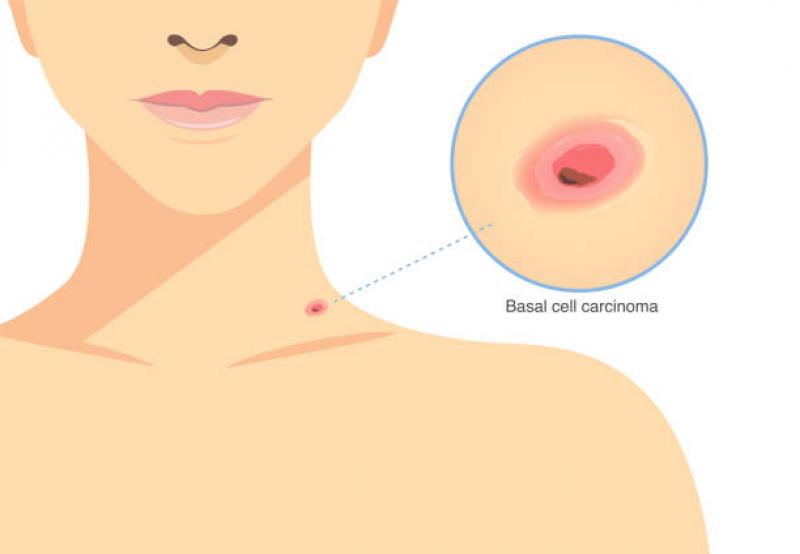Basal Cell Carcinoma: Understanding the Most Common Skin Cancer, Diagnosis, Treatment, and Prevention
Basal cell carcinoma (BCC) is the most prevalent form of skin cancer, accounting for approximately 80% of all skin cancer cases. It primarily arises from the basal cells, which are located in the deepest layer of the epidermis. Although BCC rarely metastasizes or spreads to other parts of the body, early detection and prompt treatment are essential to prevent local tissue destruction and potential disfigurement. This comprehensive article explores the characteristics of basal cell carcinoma, its risk factors, diagnostic methods, various treatment options, and essential preventive measures to protect against this common skin cancer.
- Characteristics of Basal Cell Carcinoma:
Basal cell carcinoma typically appears as a painless, slow-growing, flesh-colored or pinkish bump on the skin. It may also resemble a pearly or waxy papule with visible blood vessels. BCC most commonly occurs on sun-exposed areas, such as the face, ears, neck, scalp, and shoulders. It is more prevalent among fair-skinned individuals with a history of chronic sun exposure.
- Risk Factors:
The primary risk factor for basal cell carcinoma is excessive exposure to ultraviolet (UV) radiation from the sun or tanning beds. Other risk factors include a family history of skin cancer, fair skin that burns easily, a weakened immune system, and exposure to certain environmental carcinogens.
- Diagnosis and Subtypes:
Dermatologists use a combination of clinical examination, dermoscopy, and skin biopsy to diagnose basal cell carcinoma definitively. BCC is further categorized into different subtypes, such as nodular, superficial, morpheaform, and pigmented, each with its unique characteristics and growth patterns.
- Treatment Options:
Treatment for basal cell carcinoma depends on various factors, including the tumor's size, location, and subtype, as well as the patient's age and overall health. Common treatment options include:
a) Surgical Excision: The most common approach involves surgically removing the tumor along with a margin of healthy tissue to ensure complete eradication.
b) Mohs Micrographic Surgery: This specialized technique is highly effective for large or recurrent tumors, minimizing damage to healthy tissue while maximizing tumor removal.
c) Curettage and Electrodesiccation: Smaller BCCs may be treated by scraping the tumor and cauterizing the base with an electric needle.
d) Cryotherapy: Liquid nitrogen is used to freeze and destroy superficial basal cell carcinomas.
e) Radiation Therapy: For patients who are not candidates for surgery, radiation therapy may be employed as an alternative treatment option.
f) Topical Medications: Certain prescription creams and gels can be used for superficial basal cell carcinomas that are limited to the skin surface.
g) Hedgehog Pathway Inhibitors: Targeted therapies that block specific molecular pathways involved in BCC growth have shown promising results for advanced or metastatic cases.
- Importance of Early Detection:
Early detection and treatment of basal cell carcinoma are critical in preventing local tissue damage and avoiding the need for more extensive surgical procedures. Regular skin examinations, self-checks for suspicious lesions, and prompt reporting of any concerning changes to a dermatologist are vital for early detection.
- Prevention and Sun Protection:
Preventing basal cell carcinoma starts with protecting the skin from harmful UV radiation. This includes:
a) Applying broad-spectrum sunscreen with a high SPF regularly, especially when outdoors. b) Seeking shade during peak sun hours (10 a.m. to 4 p.m.). c) Wearing protective clothing, including wide-brimmed hats and sunglasses. d) Avoiding indoor tanning beds, which emit harmful UV radiation.
- Regular Skin Screenings:
Individuals at higher risk for skin cancer, such as those with a family history of the disease or a personal history of previous skin cancers, should undergo regular skin screenings by a dermatologist. Early detection of suspicious lesions improves the chances of successful treatment.
- The Role of Genetic Factors:
Researchers have identified specific genetic mutations associated with basal cell carcinoma. Understanding these genetic factors may pave the way for more targeted therapies and personalized treatment approaches in the future.
- Psychological Impact and Support:
Dealing with a cancer diagnosis, even one with a favorable prognosis like basal cell carcinoma, can have emotional and psychological implications. Providing emotional support, counseling, and resources to cope with the diagnosis and treatment process is essential for the well-being of affected individuals.
Conclusion:
Basal cell carcinoma is the most common form of skin cancer, affecting millions of people globally. Its association with sun exposure underscores the importance of sun protection and early detection through regular skin screenings. With advances in diagnosis and treatment options, the prognosis for basal cell carcinoma is generally excellent. Educating the public about skin cancer prevention and promoting early detection are essential in reducing the impact of this common skin malignancy. Continued research into genetic factors and targeted therapies holds promise for further improving outcomes and providing personalized treatment approaches for individuals affected by basal cell carcinoma.
